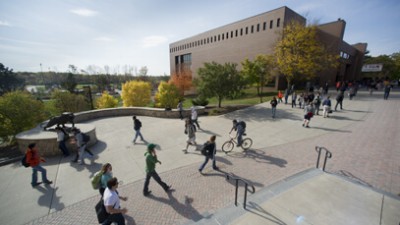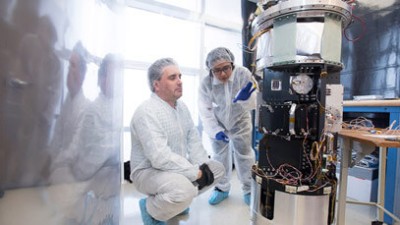News
-
March 29, 2018

Using cinema technology for space missions
RIT scientist Zoran Ninkov is developing and testing an astronomical imager inspired by an Oscar-award winning cinema projection system. The RIT astronomical imaging system is competing with other technologies for deployment on future NASA space missions for surveying star and galaxy clusters. -
March 20, 2018

‘U.S. News’ ranks RIT among best graduate schools - 2019 edition
Six RIT graduate programs are among the best in the nation, with several on the rise according to U.S. News & World Report’s 2019 edition of America’s Best Graduate Schools. -
February 16, 2018

Alumnus inducted into Inventors Hall of Fame
Steven Van Slyke ’88 (materials science) has been inducted into the National Inventors Hall of Fame for co-inventing the organic light-emitting diode, or OLED. -
February 14, 2018

New study advances multimessenger astrophysics
A new simulation of supermassive black holes, the behemoths at the centers of galaxies, uses a realistic scenario to predict the light signals emitted in the surrounding gas before the masses collide, said RIT researchers in a new paper published in the Astrophysical Journal Letters. -
October 30, 2017

Hunting for massive black-hole mergers
The outskirts of spiral galaxies like our own could be crowded with colliding black holes of massive proportions and a prime location for scientists hunting the sources of gravitational waves, according to RIT researchers.
-
October 16, 2017

RIT researchers part of breakthrough discovery
RIT researchers played a significant role in an international announcement today that has changed the future of astrophysics. The breakthrough discovery of colliding neutron stars marks the first time both gravitational waves and light have been detected from the same cosmic collision. -
August 16, 2017

Astrophysics Ph.D. student wins NASA fellowship
RIT graduate student Chi Nguyen was selected for a NASA Earth and Space Science Fellowship in Astrophysics Research, one of eight fellowship recipients selected from 141 applicants to the Astrophysics Science Research Program. -
August 9, 2017

RIT physicist studies quantum sensing solutions
Research conducted by Mishkat Bhattacharya, a theoretical physicist, is advancing a new kind of sensing technology that captures data with better precision than currently possible and promises cheaper, smaller and lighter sensor designs. -
July 3, 2017

RIT launches Integrated Sciences Academy
The Integrated Sciences Academy in RIT’s College of Science will bring together researchers with different expertise to invent new ways to approach challenges facing a global society. -
May 12, 2017

Lea Vacca Michel earns the 2017 Edwina Award
Lea Vacca Michel, associate professor in the School of Chemistry and Materials Science, received the 2017 Edwina Award at the Women’s Career Achievement Dinner on April 24 for her significant contributions to enhance gender diversity and inclusiveness at RIT. -
November 16, 2016

Researchers fix Landsat 8 imagery, measurements
Software developed by Aaron Gerace and Matt Montanaro, senior scientists at RIT’s Chester F. Carlson Center for Imaging Science, improves the accuracy of NASA’s Landsat 8 Earth-sensing satellite, which was giving inaccurate readings due to defective optics in the thermal infrared sensor.




